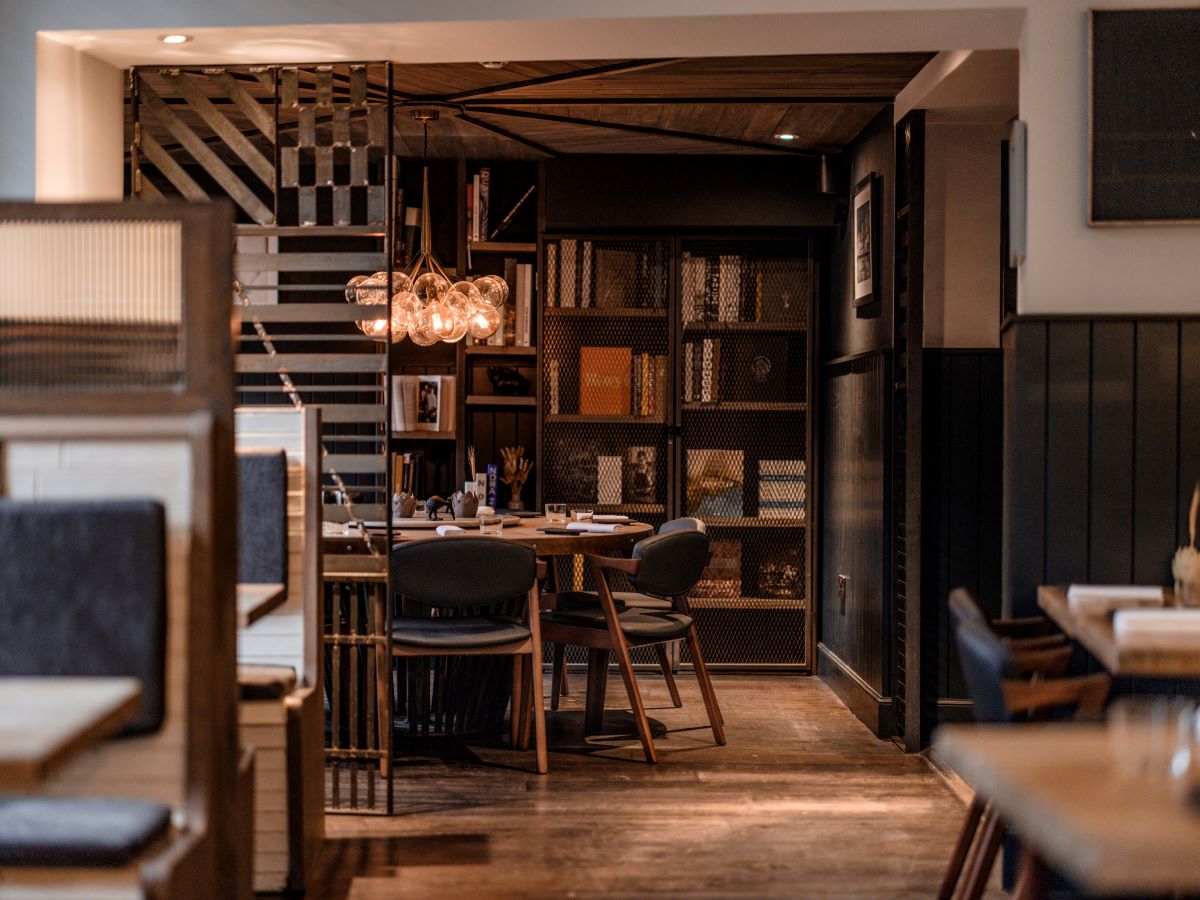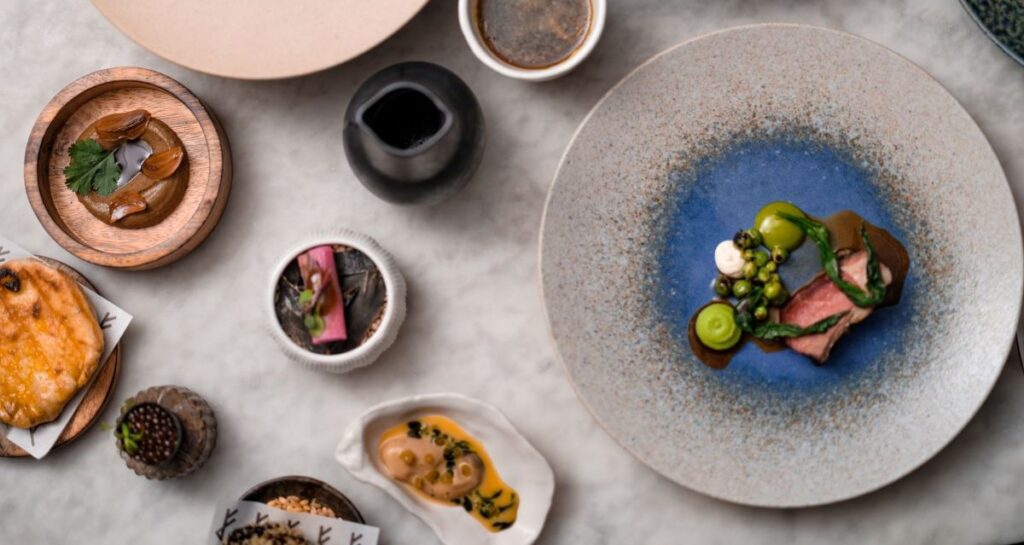I’m a fan of people who have the confidence to try and rehabilitate spaces that haven’t worked for other restaurateurs. It bore fruit in Edinburgh for four Michelin-starred establishments in Tom Kitchin and Heron in Leith, and for a pair of Old Town establishments in Dominic Jack at Castle Terrace (until Covid intervened) and the Radfords at the Timberyard.
Another chef-patron trying a spot of gastronomic alchemy is Dan Ashmore, who has teamed up with the Dean Banks Group to try and make a success out of the space which until recently housed The Chophouse in Leith. Covid and then the long-term disruption of the tram works eventually did for the Chophouse, but with expensive décor, a top-end kitchen and a site that’s 100 yards from the Foot of the Walk tram stop, this site was always going to be snatched up quickly.
So it was no surprise when the hyperactive duo of Ashmore and Banks – he of Haar and Dune in St Andrews, Dulse and The Pompadour in Edinburgh – took over the site. Ashmore worked at the 2 Michelin-starred restaurants The Square and Restaurant Tom Aikens in London, before becoming sous chef at Number One at The Balmoral and then becoming head chef at the Pompadour at the Waldorf Caledonian when it was run by the Galvin brothers, so he comes with a prestigious pedigree.
The USP of their new venture is reflected in its name, Askr, which is the Old Norse word for ‘ash’. The idea is that Ashmore cooks dishes wherever possible over flames and coals, using a three-tier construction. I’ve always been fascinated by this form of cooking since a long conversation with the now dearly departed Andrew Fairlie where he talked about his first job, which was cooking over hot coals on a safari camp, which he loved and believed was a key reason why he rose to the giddy heights of two Michelin stars.
Our culinary journey started with cocktails at the bar, followed by a place in the six high seats along a countertop looking into an open prep station, from where Ashmore chatted to us while making two canapes. He’s engaging, outgoing and interesting, and is obviously happy to answer diners’ questions. This format is similar to that offered by The Table and Eorna, but this interaction is only a small part of the mix, which is an excellent innovation. In fact, the burned croustade with turbot roe a chive emulsion and taramasalata he prepared as we watched was arguably the most arresting dish we had all night, although the other canape, of mackerel with kombucha ketchup and pickled ginger, was also an interesting process and a nice palate cleanser.

From there we moved to a table in the body of the main restaurant so that other diners could chat to Ashmore and we could get on with the remaining dishes in the 13-course odyssey. As we waited for the next course to arrive we had a chance to assess our surroundings, and there’s no doubt that what were already quite swanky decor in the days of The Chophouse has been made even more top-end. Just to make the point, a bride and groom had decided to come and have dinner there on their wedding day, with the bride still wearing her wedding dress.
The first proper course was a Cumbrae oyster (which I usually love) which had been dry-aged and was then served in a creamy sauce which somehow obscured this oyster’s trademark silkiness. Far better was Ashmore’s buttery take on a chicken wing, which was cooked over coals and melt-in-the-mouth tender.
As with most tasting menus, the courses now came thick and fast. Next up was what was described as a flatbread, but which was more like a sourdough suffused in olive oil, which came with a deep, pungent aubergine dip and got a thumbs up. Less well-received was a small, fiddly beetroot concoction with apple and crème fraiche, which came in a bowler hat-shaped bowl so deep that the aesthetics of its intricate construction were largely lost.
We moved into the seafood phase with a scallop dish that was given piquancy by an nduja foam, but which came with borlotti beans which were a little too al dente for me. This was followed by a dish of monkfish, which Ashmore dry-ages for up to ten days, which was crusted in walnuts and served with asparagus and an asparagus sauce.
The next two dishes were the highlight of the meal. The first was lobster cooked in wagyu fat, which came with lobster claw meat in tempura, little oily. Then a beaker of duck consommé with mushrooms, which we loved, followed by duck breast with brassica, apricot and hoisin sauce.
Our meal was now winding down, starting with a hunk of excellent brie-style Baron Bigod cheese served with pickled walnut and quince jelly, and followed by a slightly cloying bergamot pudding with lemongrass, rounding off with a strawberry, yoghurt and vanilla dish and then four excellent petit fours.
What to make of it all? There was much about this experience was good – the staff were the perfect mix of unobtrusive yet knowledgeable and informative when necessary, Ashmore himself was a joy to engage with, and the surroundings were high-quality yet comfortable and convivial. The highlight was a parade of really well curated wines which complemented the meal perfectly, with a buttery and easy drinking white wine from Patagonia the standout.
At £115 for the signature tasting menu (the pared down Discovery menu is £85, while paired wines are £65-75), I’m still a little unconvinced by the merits of the ‘flame and coals’ methodology, and think at that pricing Askr remains a work in progress. However, the £45 three-course a la carte menu and the two lunch menus – the four-course lunch and the half-lobster lunch are both £35 – look like good value and will undoubtedly be explored by many visiting diners during the festival.
But above all let’s hope that, like Kitchin and all of those who’ve converted failing sites into thriving spaces, Askr is with us for years to come.
ASKR: 102 Constitution Street, Leith, Edinburgh EH6 6AW. 0131 283 3309.
Read more Reviews here.
Subscribe to read the latest issue of Scottish Field.
TAGS


